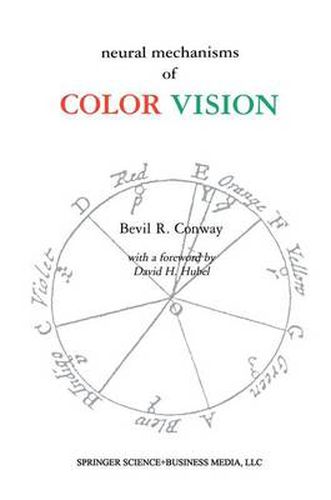Readings Newsletter
Become a Readings Member to make your shopping experience even easier.
Sign in or sign up for free!
You’re not far away from qualifying for FREE standard shipping within Australia
You’ve qualified for FREE standard shipping within Australia
The cart is loading…






How the brain represents colour remains one of the most controversial topics in neurophysiology. We know that colour is represented through an opponent mechanism, demonstrated by the fact that some colours are exclusive of others. Yet how these antagonistic chromatic axes are represented in the cortex has been a mystery. Dr Conway has mapped the spatial and temporal structure of the cone inputs to single neurons in the primary visual cortex of the alert macaque. Colour cells had receptive fields that were often double-opponent, an organization of spatial and chromatic opponency sufficient to form the basis for colour constancy and spatial colour contrast. Almost all colour cells gave a bigger response to colour when preceded by an opposite colour, suggesting that these cells also encode temporal colour contrast. In sum, colour perception is likely subserved by a subset of specialized neurons in the primary visual cortex. These cells are distinct from those that likely underlie form and motion perception. Colour cells establish three colour axes sufficient to describe all colours; moreover these cells are capable of computing spatial and temporal colour contrast - and probably contribute to colour constancy computations - because the receptive fields of these cells show spatial and temporal chromatic opponency.
$9.00 standard shipping within Australia
FREE standard shipping within Australia for orders over $100.00
Express & International shipping calculated at checkout
How the brain represents colour remains one of the most controversial topics in neurophysiology. We know that colour is represented through an opponent mechanism, demonstrated by the fact that some colours are exclusive of others. Yet how these antagonistic chromatic axes are represented in the cortex has been a mystery. Dr Conway has mapped the spatial and temporal structure of the cone inputs to single neurons in the primary visual cortex of the alert macaque. Colour cells had receptive fields that were often double-opponent, an organization of spatial and chromatic opponency sufficient to form the basis for colour constancy and spatial colour contrast. Almost all colour cells gave a bigger response to colour when preceded by an opposite colour, suggesting that these cells also encode temporal colour contrast. In sum, colour perception is likely subserved by a subset of specialized neurons in the primary visual cortex. These cells are distinct from those that likely underlie form and motion perception. Colour cells establish three colour axes sufficient to describe all colours; moreover these cells are capable of computing spatial and temporal colour contrast - and probably contribute to colour constancy computations - because the receptive fields of these cells show spatial and temporal chromatic opponency.